I have to make a conscious effort to ensure mathematics gets equal time in our house. And, really, there are so many mathematics learning possibilities in play!
Just spending ten minutes with dice or coins opens up a world of possibilities.
We grabbed our jar of change and sorted our coins.
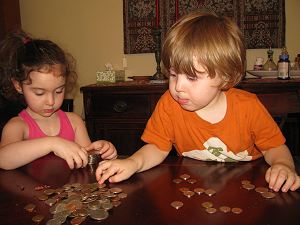
Even toddlers (at least the ones past the mouthing stage) can participate in this step.
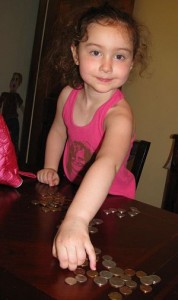
Then, I printed out a sheet with 10 columns and labeled the top 1-10
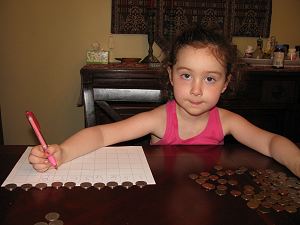
…but in the future, we’ll use this sheet I just made:
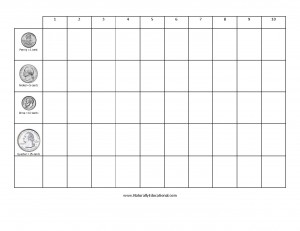 We lined up the coins with the sheet and began to count by fives.
We lined up the coins with the sheet and began to count by fives.
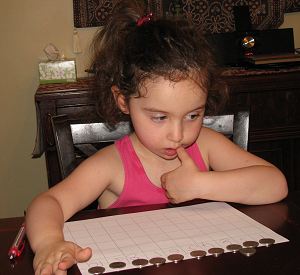
My daughter remembered the pattern (ends in 5, ends in 0) once she got started.
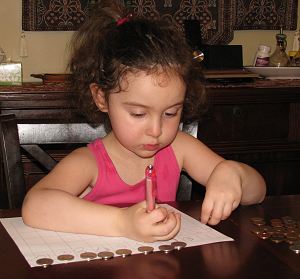
I pointed out that you could do the same with groups of five pennies.
We also discussed how skip counting is essentially multiplication, using four nickels as an example (4 x5 = 20).
She said, “But 10 + 10 equals 20. Oh, wait! 5+5 (grabbing two nickels) equals 10 and 5+5 (grabbing two more nickels) equals 10 and then (pushing all four together) 10 + 10 equals 20! I see!”
This is why math manipulatives are so helpful!
We’ll do more skip counting, multiplication, and addition practice with the coins this summer.
Adaptations for younger kids:
- Practice counting with pennies. Can you count up to 100? That’s a dollar!
- What symbols do you see on the coins? Find out what these symbols represent.
More activities for kindergarten and early elementary:
- Try skip counting by tens and then by 25, using dimes and quarters.
- Practice addition using the coins and number cards or multiplication (using your skip counting chart).
- Put your change in a jar and estimate the amount of change you have. Would you rather have a jar full of pennies, nickels, dimes or quarters? Think about both the size and the value amount of these coins. Then count your change using skip counting techniques. How close were you? What could you buy with the change?
- Try cleaning some of the more tarnished pennies. Which solution works best?
- What symbols do you see on the coins? Find out what these symbols represent.
- How many pennies does it take to make a dollar? Do you think you and your friends could collect $100 in pennies and other small change for charity? How about $1000? Pick a charity and collect pennies and see how they add up! Every little bit counts!
Adaptations for older kids:
- Practice fractions and percentages using coins. For example, there are 10 dimes in a dollar; what fraction of a dollar is two dimes (20 cents)? Or, what percentage of a dollar is 34 pennies?
- Pretend you come from a culture in the future that does not know much about our time. You have found a penny in an archeological dig. Observe it closely. Make a T-chart and record your observations on one side of the chart. Make hypotheses based on your observations on the other side of the chart. What can you tell about our culture from our coins? Would these logical hypotheses be correct?
—
This post is part of the Smart Summer Challenge. Check out our family’s plans for Week 2: Government and Currency, find out more about the Smart Summer Challenge and grab our free calendar of summer learning ideas, and “like” the Smart Summer Challenge page on Facebook.

Find more great ideas from your hostesses, Candace of Naturally Educational (that’s me!), Amy of TeachMama.com, and MaryLea of Pink and Green Mama!
Hope to see you at the linky party on Friday for ideas from the community and prizes!
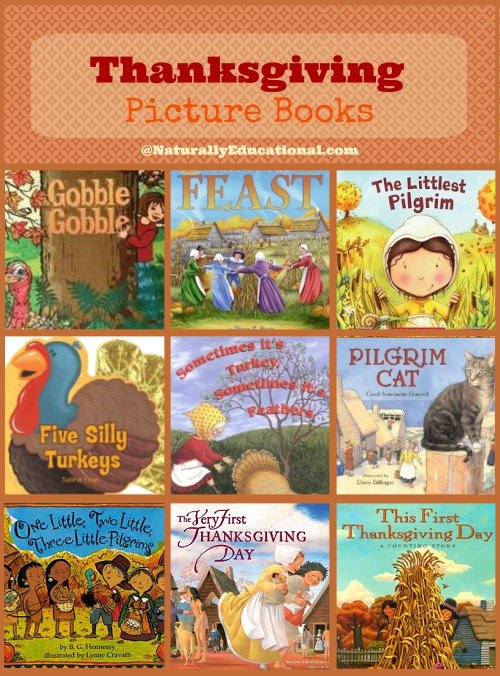
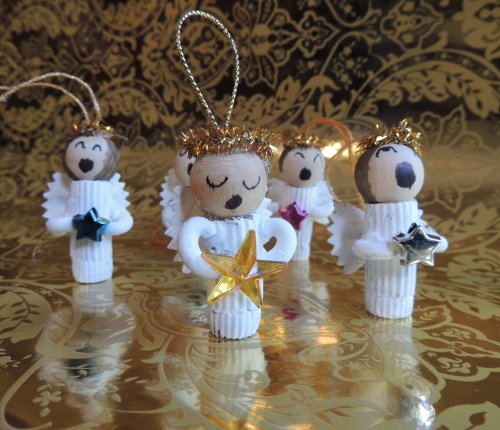
Great worksheet TFS! We did some skip counting with dimes not to long ago, this will be a great addition to the next time we pull it out! 😀